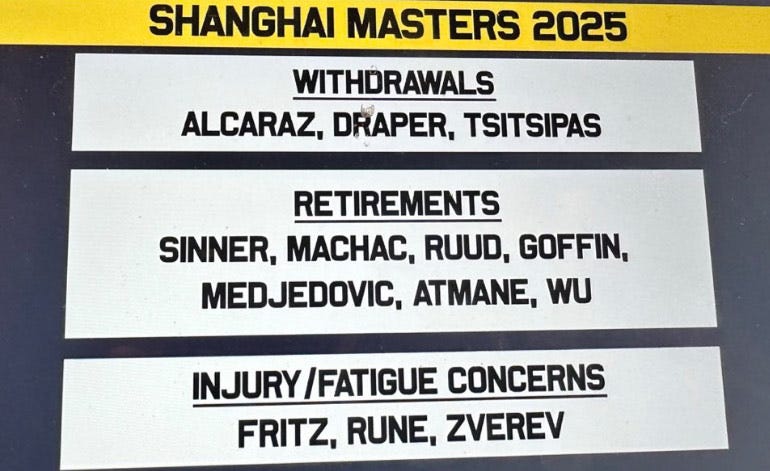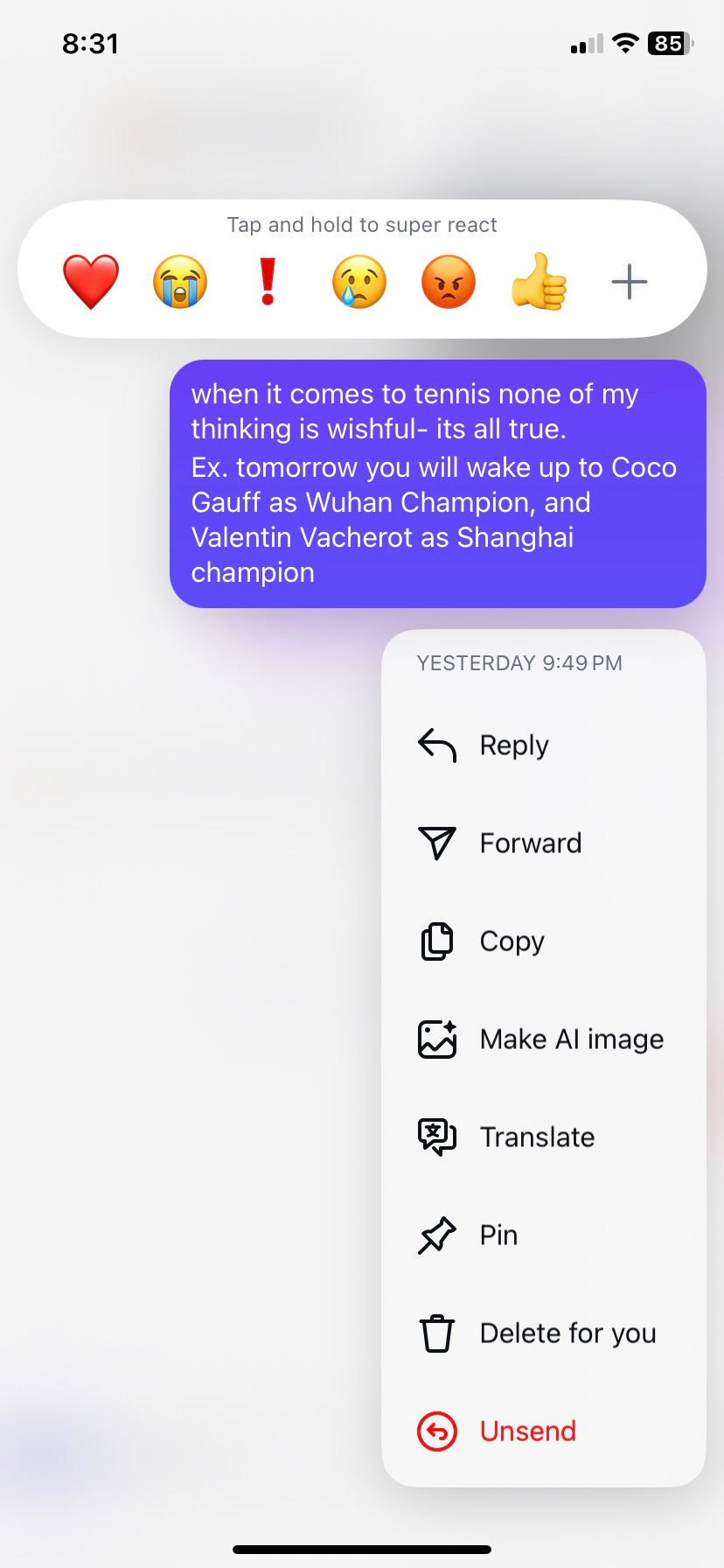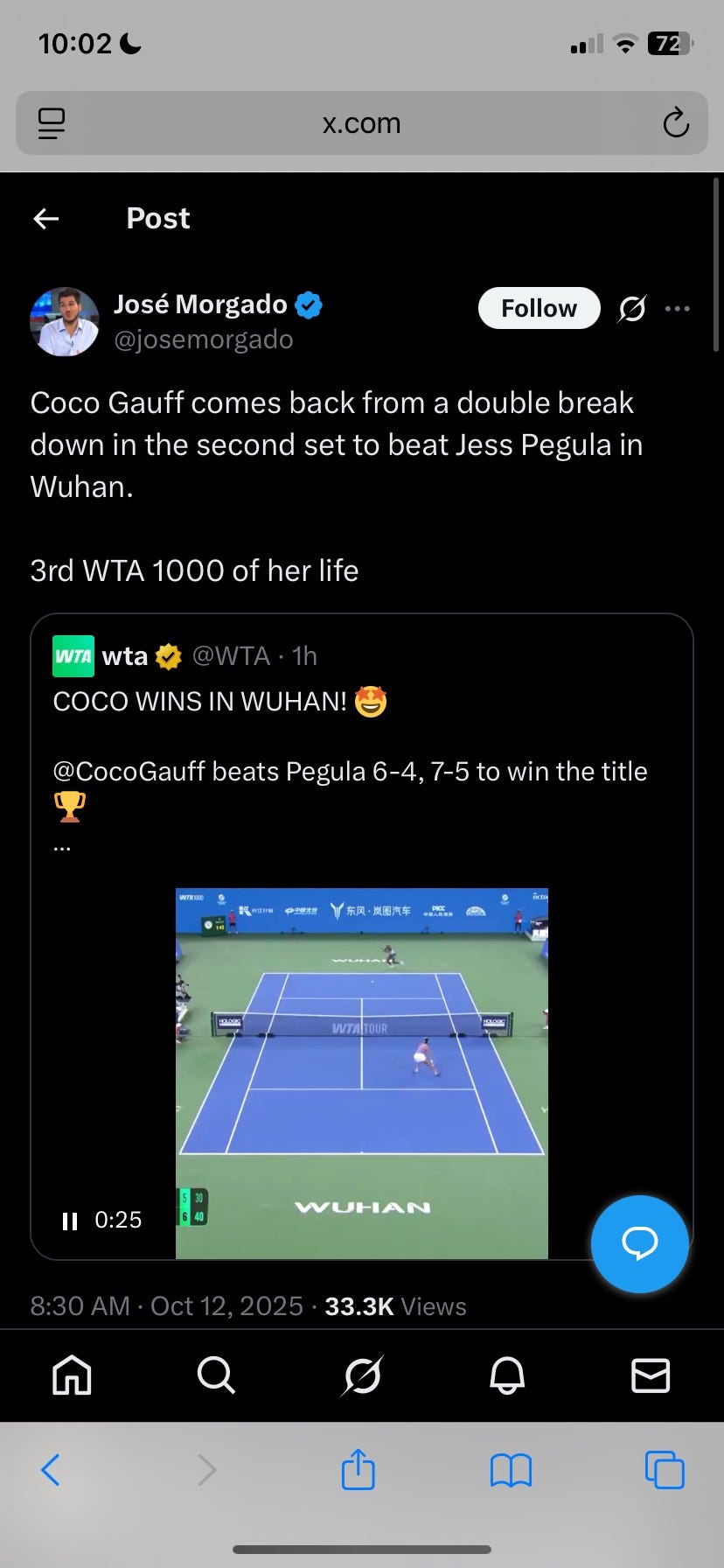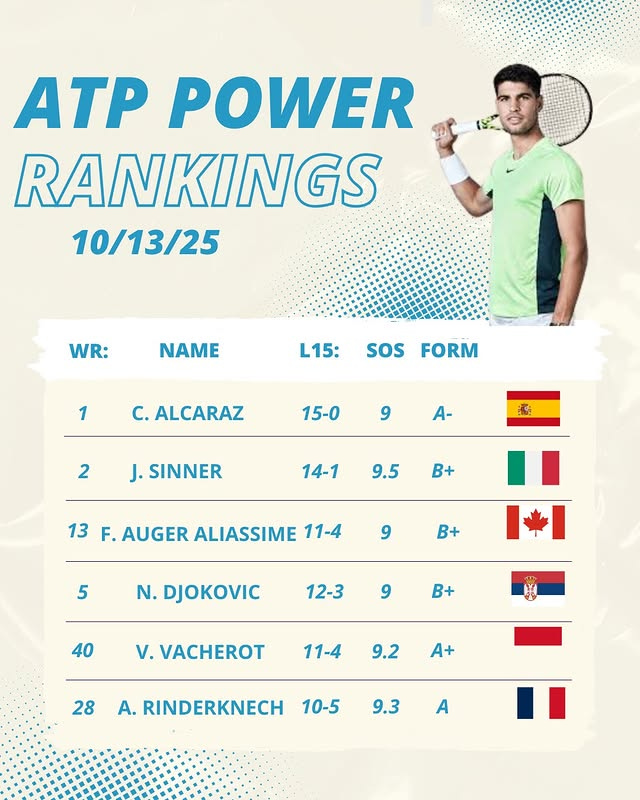Bagels With Brendan, Issue #24: Coco Is Back, History in Shanghai, and Morgado Is Still Pathetic
I’m back from my adventure in the woods.
For five days, I actually lived in the wilderness — I went to the bathroom in the woods, slept in a tent, and hiked about four miles every day (most of it either straight uphill or straight downhill) while carrying roughly 60% of my body weight on my back. The pack was 70 pounds. You can do the math.
I didn’t shower the entire time and had no music — unless you count Jon’s ukulele on the last night.
But worst of all...
I had no idea what was happening in the tennis world.
The trip was still super fun, though!
And I quickly caught up once I got back.
I’m really good at playing ketchup.
Let’s check in on the women first!
Wuhan: Coco Is Back
In Wuhan, the spotlight was on five players:
Iga Świątek, Jasmine Paolini, Aryna Sabalenka, Jessica Pegula, and Coco Gauff.
Let’s start with Świątek and Paolini.
After Świątek’s fourth-round loss in Beijing to Emma Navarro — where she got bageled in the final set — her chances of reclaiming the year-end No. 1 spot were looking slim heading into Wuhan.
In Wuhan, Świątek reached the quarterfinals, where she met Italian Jasmine Paolini for the fifth time on tour. Their previous results:
2022 U.S. Open R1: Świątek def. Paolini 6–3, 6–0
2024 French Open Final: Świątek def. Paolini 6–2, 6–1
2025 Bad Homburg Semifinal: Świątek def. Paolini 6–1, 6–3
2025 Cincinnati Final: Świątek def. Paolini 7–5, 6–4
Safe to say, Świątek had the advantage going into the match.
However, that didn’t matter much.
Paolini absolutely decimated her — 6–1, 6–2.
The Italian hit only three unforced errors the entire match. Insanity.
She also hit 15 winners, giving her a winners-to-unforced-errors (W/UFE) ratio of 5.0.
Świątek, on the other hand, hit 10 winners to 20 unforced errors — a W/UFE ratio of 0.5.
This result ensured that, for the second straight year, Aryna Sabalenka and Iga Świątek would finish the season ranked World No. 1 and No. 2 respectively.
It’s an extremely concerning result for Świątek, who’ll be entering the WTA Finals with little momentum.
For Paolini, though, this was a career-defining win. It takes enormous mental strength to beat an opponent you’ve never beaten before.
Ironically, Coco Gauff — who was 0–3 against Paolini this year — defeated the Italian 6–4, 6–3 in the semifinals.
On the other side of the draw, Aryna Sabalenka — who had never lost a match in Wuhan — blitzed through her draw after a shaky opener against Sramkova. Her 6–3, 6–3 win over Elena Rybakina in the quarters marked her 20th straight victory in Wuhan and set up a clash with American Jessica Pegula.
Pegula had fought tooth and nail to get there — her quarterfinal win over Siniakova was her seventh straight three-set match.
She had beaten Sabalenka only twice in their ten previous matchups, the most recent nearly two years ago at the WTA Finals in Cancun.
To make matters worse, she had lost a heartbreaker to Sabalenka at this year’s U.S. Open, despite losing only four points on serve in the final set. And just last week, she squandered three match points against Noskova in the Beijing semifinals, losing 8–6 in the third-set tiebreak.
So yeah — the odds were stacked against Pegula.
Especially after Sabalenka took the first set 6–2.
However, Pegula clawed back, taking the second 6–4.
After splitting the first four games of the decider, Sabalenka surged ahead 5–2. It looked over.
But Pegula refused to quit. She stormed back to force a deciding tiebreaker.
At that point, almost everyone thought she was done.
Sabalenka had won 19 straight tiebreakers — she hadn’t lost one since February.
But Pegula broke the streak, winning 7–2 and booking her spot in the final against Coco Gauff — who, over the past few weeks, has reminded everyone why she’s a true champion.
Last week in Beijing, the same site where she won her only Masters 1000 title of 2024, Gauff reached the semifinals — only to get thrashed by Amanda Anisimova 6–1, 6–2 in just over an hour.
After that result, many doubted Gauff’s chances in Wuhan.
Her first-round opponent was Uchijima — a rematch of their Indian Wells first-round clash back in March, where Gauff barely escaped 7–6 in the third despite hitting 21 double faults and 60 unforced errors.
This time, it couldn’t have been more different.
Gauff dominated from start to finish — 5 aces, 0 double faults, and just 5 missed first serves all match. She hit 16 winners to only 8 unforced errors in a 51-minute 6–1, 6–0 rout.
The rest of her run was just as smooth — defeating Zhang 6–3, 6–2, Siegemund 6–3, 6–0, and Paolini 6–4, 6–3.
In the final against Pegula, Gauff was rock solid, winning 6–4, 7–5.
She hit 24 winners to 22 unforced errors, capturing her third Masters 1000 title and 11th title overall.
She also made history — losing the fewest games en route to the Wuhan title since the tournament’s inception in 2014. She dropped just 25 games, shattering Petra Kvitova’s record of 36.
With the win, Gauff improved to 9–0 in hard court finals, becoming the first player since Serena Williams to win nine consecutive hard-court finals.
My Prediction for Coco Gauff
Last year, after her fourth-round loss to Navarro at the U.S. Open, Gauff fired Brad Gilbert and shifted her focus toward developing new areas of her game — taking the pressure off results. It worked instantly. She made a Masters 1000 semifinal, then won a Masters 1000 title. After that, she captured the WTA Finals.
That momentum carried into early 2025, when she showed — over five United Cup matches — what I believe was the highest level of women’s tennis this decade.
This year, after her fourth-round loss to Osaka at the U.S. Open, Gauff made similar adjustments — and once again, the results followed. A Masters 1000 semifinal. Another Masters 1000 title.
I think she’s going to win the WTA Finals this year. Without question.
Her new coach, Gavin MacMillan, has already worked wonders. Gauff is showing more variety, patience, and consistency, and her serve looks better than ever.
The only question is how far this momentum will carry.
Last year, it extended through the United Cup before she fell to Badosa in the Australian Open quarterfinals. Maybe this time, she pushes even further. Her best result in Melbourne so far is a semifinal in 2024 — can she top that in 2026?
Only time will tell.
Regardless, Wuhan alone is enough justification for me to put Coco Gauff at the top of my WTA power rankings list.
You can view the full list — plus some bonus stats — on my Instagram page @bagelswithbrendan, which will be linked at the end of this newsletter.
Family Affair in Shanghai
So — complete insanity just happened in Shanghai.
I want to start off by saying there’s a reason for it.
The conditions were absolutely brutal.
This graphic — courtesy of Tennis Talk with Cam Williams — says it all.
Family Affair in Shanghai
So — complete insanity just happened in Shanghai.
I want to start off by saying there’s a reason for it:
The conditions were absolutely brutal.
This graphic — courtesy of Tennis Talk with Cam Williams — says it all.
These were all from just the first week.
Sinner and Alcaraz were obviously the two biggest names on the list.
With both of them out, it felt like anybody’s tournament.
Still, their absence doesn’t make what happened in Shanghai any less extraordinary.
Okay — with that being said, let’s get into it.
When Luca Nardi withdrew from qualifying in Shanghai, World No. 204 Valentin Vacherot took his place in the draw. He went on to defeat Basavareddy and Draxl, officially qualifying for the main draw.
In the first round, he beat Laslo Djere in straight sets before mounting a comeback to take down 14th seed Alexander Bublik in the next round. In the following round, an injured Tomas Machac retired midway through what was already turning into a beatdown — sending Vacherot to the Round of 16. There, he dropped the first set but came back to defeat Tallon Griekspoor.
In the quarterfinals against Holger Rune, Vacherot again lost the first set — and again stormed back to win the next two.
That set up a semifinal showdown with none other than Novak Djokovic.
Meanwhile, on the other side of the draw, Frenchman Arthur Rinderknech — best known for defeating Zverev in the first round of Wimbledon earlier this year — was putting together a run just as wild.
He took out Michelsen in the second round, upset Zverev again in the third, beat Lehečka in the Round of 16, and knocked out Auger-Aliassime in the quarters.
That set up a semifinal clash with Daniil Medvedev.
So the semifinals looked like this:
Djokovic (WR #5) vs. Vacherot (WR #204)
Medvedev (WR #18) vs. Rinderknech (WR #54)
Obviously, Rinderknech and Vacherot stand out here.
Now, you might be wondering:
“Brendan, what’s so extraordinary about this? With Sinner and Alcaraz out and so many top players injured, it’s not that crazy that a random made the semis!”
For anyone thinking that, I have five words for you:
Vacherot and Rinderknech are cousins.
Yup — bet you didn’t see that one coming.
What are the odds?
When I found that out, I was honestly stunned.
Still, I figured we’d get a Djokovic–Medvedev final.
After all, it’s practically tennis law that Cinderella stories end in the semifinals.
But, to quote Travis Liese:
“Family rivalry is one hell of a drug.”
Vacherot defeated Djokovic 6–3, 6–4.
Djokovic played okay — but Vacherot played excellent.
That win must’ve lit a fire under his cousin, because Rinderknech pulled off his own comeback against Medvedev, winning 4–6, 6–4, 6–2.
Before facing each other, the two cousins even practiced together — an extremely rare occurrence, but these were special circumstances.
The Final
The final began with Rinderknech racing out to an early lead, taking the first set 6–4. But Vacherot raised his level, winning the second 6–3.
And in the deciding set, Vacherot went to another gear entirely.
Like — a lot higher.
There have been very few sets in tennis history where a player has sustained such a ridiculously high level of play from start to finish. This was one of them.
With his win over his cousin in the final, Vacherot made history — becoming the lowest-ranked player ever to win a Masters 1000 title. He’s also the first player from Monaco to win an ATP singles title.
Vacherot’s performance earns him the No. 5 spot on my power rankings — I’ll need to see a bit more before I move him higher.
His cousin Rinderknech comes in right behind him at No. 6.
You can view the full list — plus some bonus stats — on my Instagram page @bagelswithbrendan, which will be linked at the end of this newsletter.
3 Images of the Week
To close out this issue, I’m starting a new tradition:
At the end of every issue, I’ll include three images that stood out to me that week.
Let’s start.
Image 1: A message I sent on Instagram Saturday night.
Image 2:
“Of her life???”
What a wierdo- Issue #23 is aging like fine wine. 🍷
Image #3






